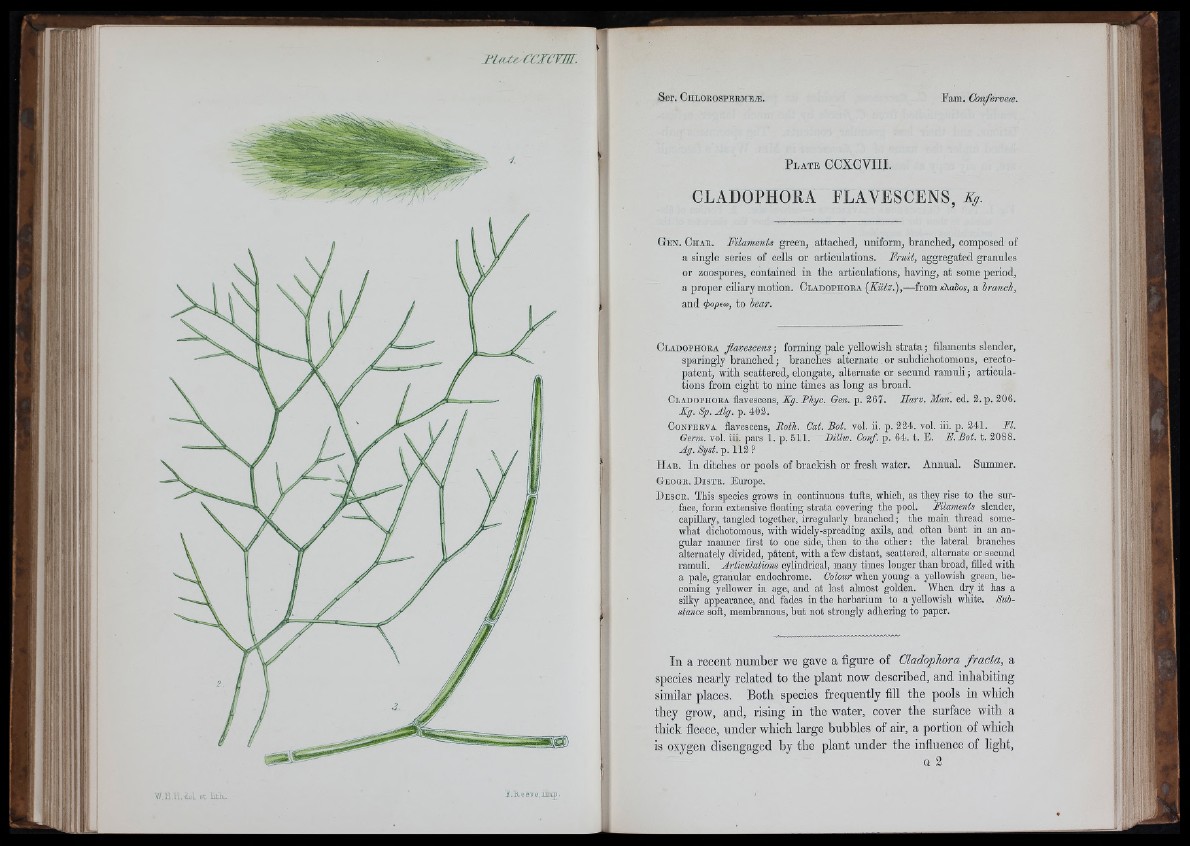
Y
F liU eF 'C IC rn i.
VÎ.H.H.tUi rt litk . i'.Keeve,iDxp-
P l a t e CCXCVIII.
CLADOPHORA FLAVESCENS, Kg.
G en . Ch a e . Filaments gre en, a tta ch e d , u n iform, b ran c h ed , composed of
a single series of cells or a rticu la tio n s . Fruit, ag g re g a ted g ran u le s
o r zoospores, co n ta in ed in th e a rtic u la tio n s , h av in g , a t some period,
a p ro p e r ciliary m o tio n . Cladophora [Kiitz.),— from «XaSos, a branch,
a n d fiopem, to bear.
C ladophora flavescens; fo rm in g pale yellowish s t r a t a ; iilaments slender,
sp arin g ly b r a n c h e d ; b ra n c h es a lte rn a te or sub d ich o tom o u s, erecto-
p a te n t, w ith sca tte re d , e longate, a lte rn a te o r s ecu n d r am u li; a rtic u la tio
n s from e ig h t to n in e tim e s as lo n g as broad.
Cl a d o ph o r a flavescens, Xg. Fhyc. Gen. p. 267. Harv. Man. ed. 2. p. 206.
Kg. Sp. Alg. p. 402.
C o n fe r v a flavescens, Roth. Cat. Bot. vol. ii. p. 224. vol. hi. p. 241. Bl.
Germ. vol. iii. pars 1. p. 511. Billw. Conf. p. 64. t. E. E.Bot. t. 2088.
Ag. Syst. p. 112 ?
H a b . I n d itches or pools of b ra c k ish o r fre sh w a ter. A n n u a l. Summer.
G e o g e . D is t r . Europe.
D e so r . This species grows in continuous tufts, which, as they rise to the surface,
form extensive floating strata covering the pool. Mlaments slender,
capillary, tangled together, irregularly branched; the main thread somewhat
dichotomous, with widely-spreading axils, and often bent in an angular
manner first to one side, then to the oth e r: the lateral branches
alternately divided, phtent, with a few distant, scattered, alternate or secund
ramuli. Articulations cylindrical, many times longer than broad, filled with
a pale, granular endochrome. Colour when young a yellowish green, becoming
yellower in age, and at last almost golden. When dry it has a
silky appearance, and fades in the herbarium to a yeUowish white. Sui-
soft, membranous, but not strongly adhering to paper.
In a recent number we gave a figure of Cladophora fracta, a
species nearly related to the plant now described, and inhabiting
similar places. Both species frequently fill the pools in which
they grow, and, rising in the water, cover the surface with a
thick fleece, under which large bubbles of air, a portion of which
is oxygen disengaged by tbe plant under the influence of light,
Q 2
i-l